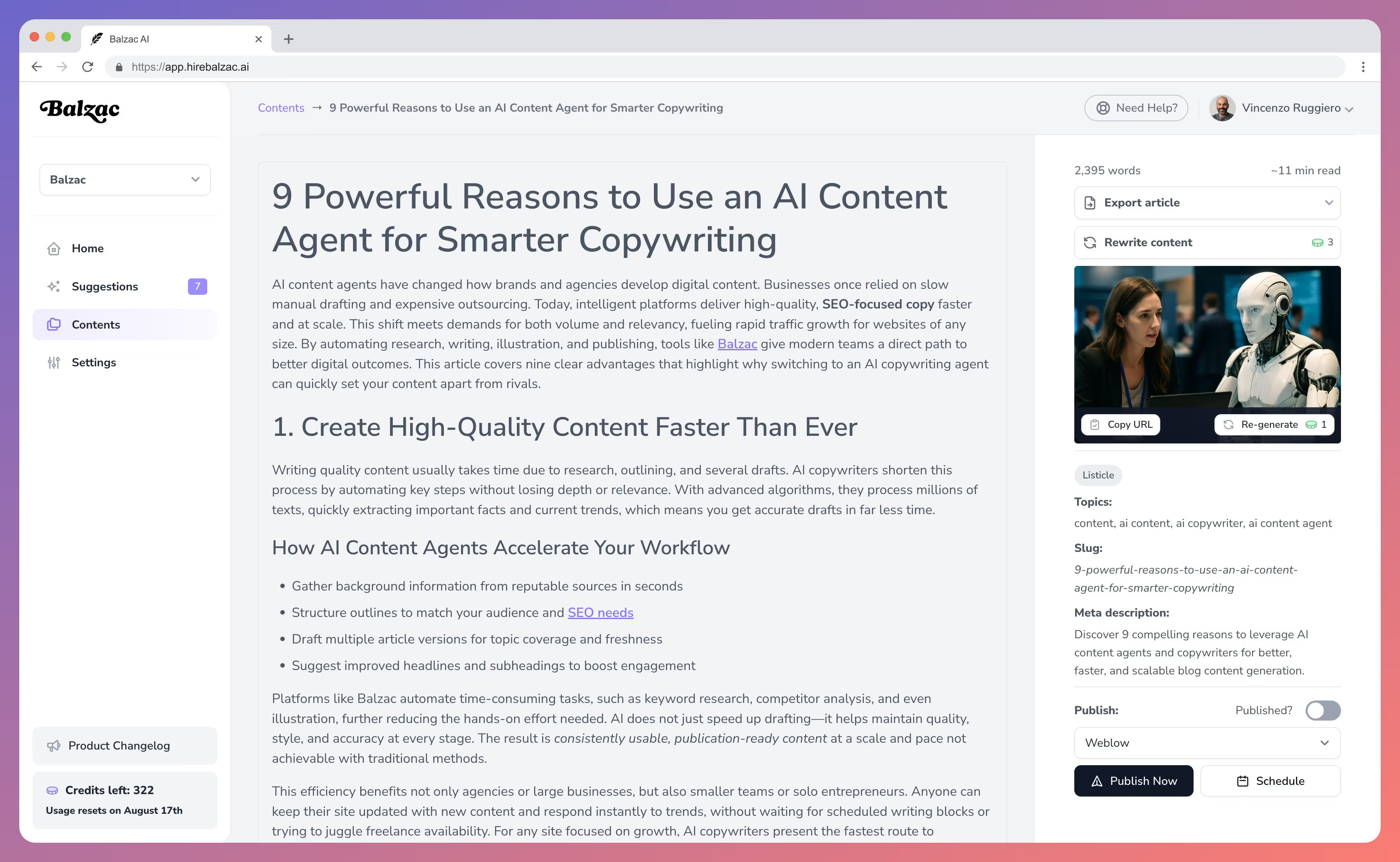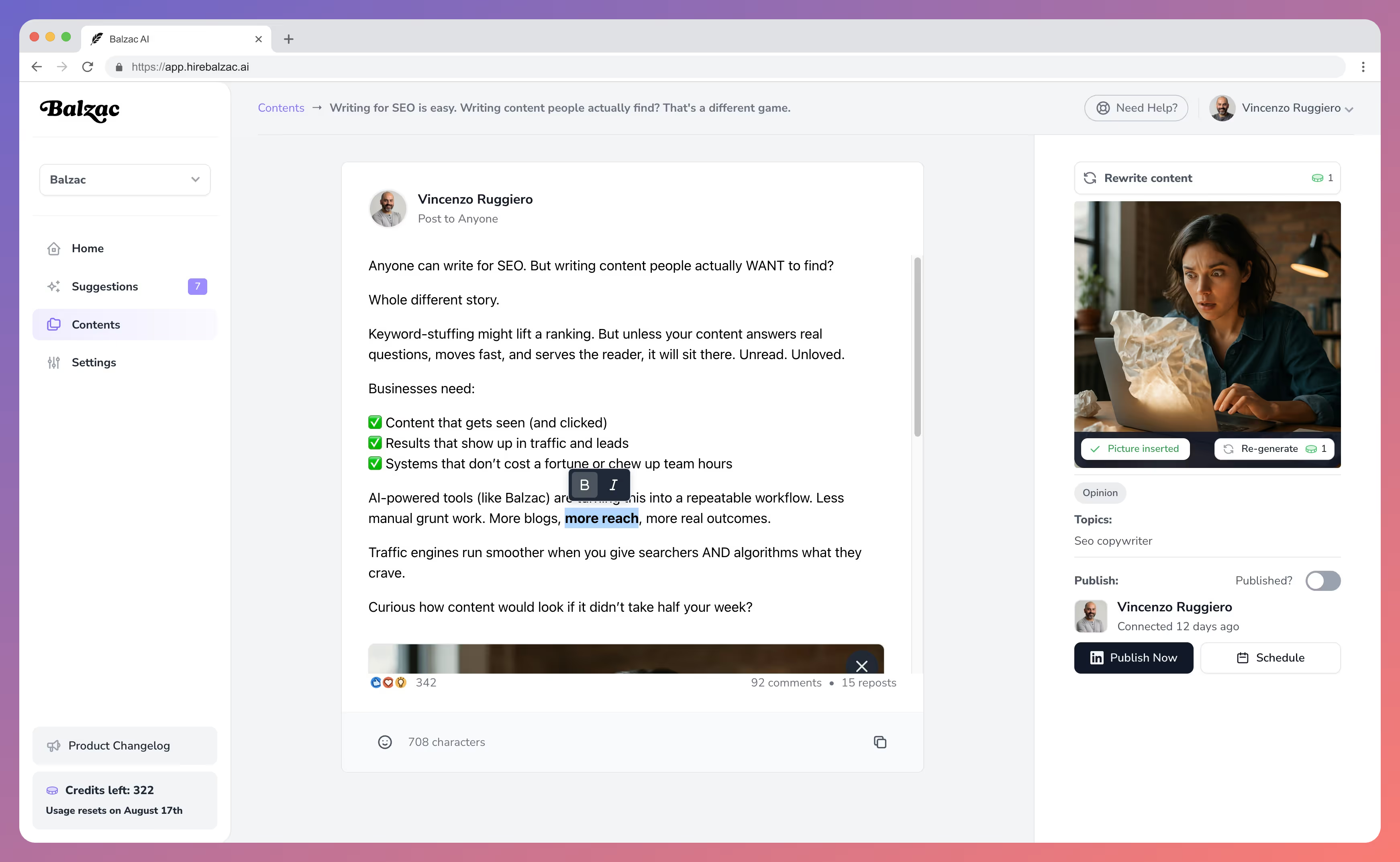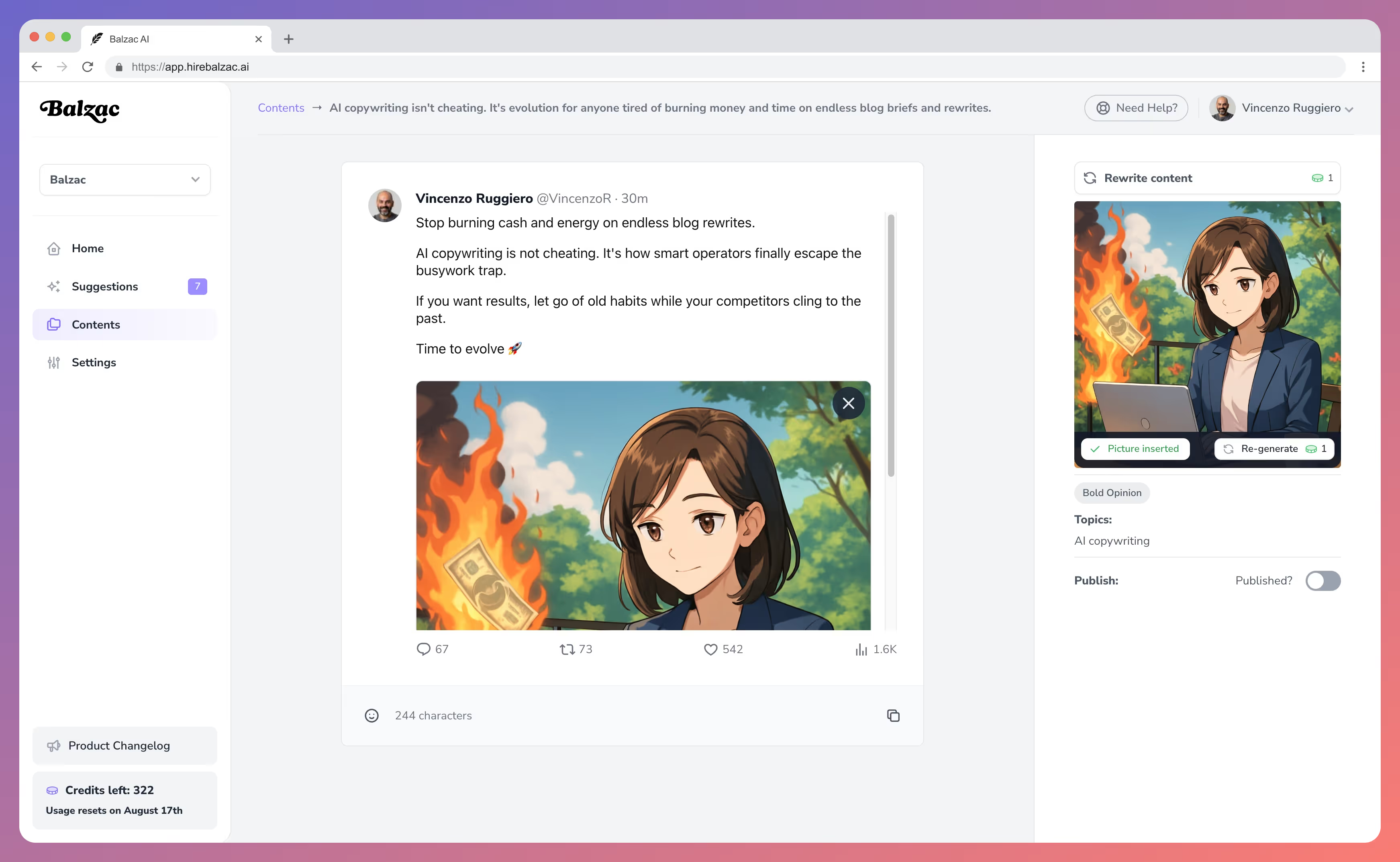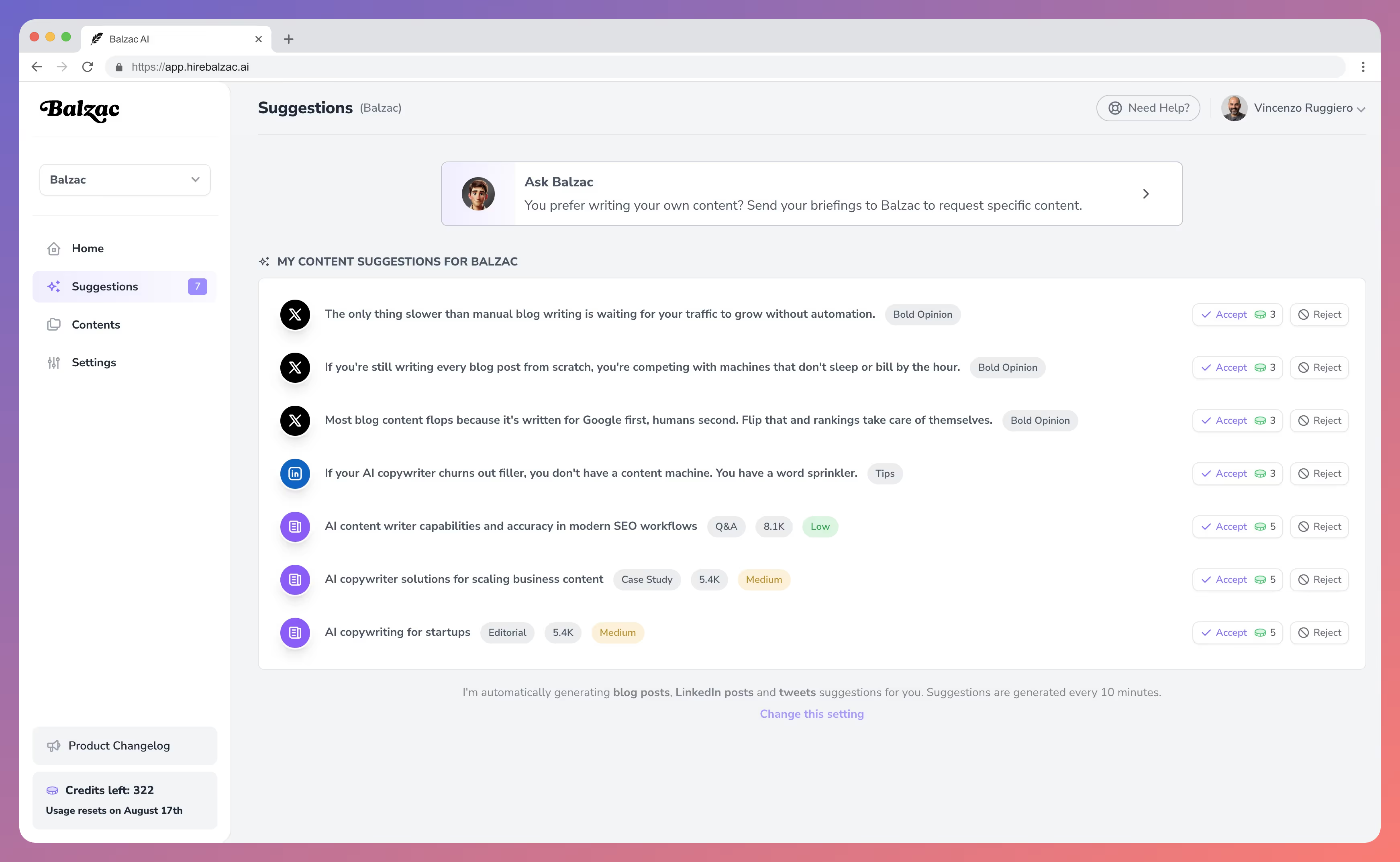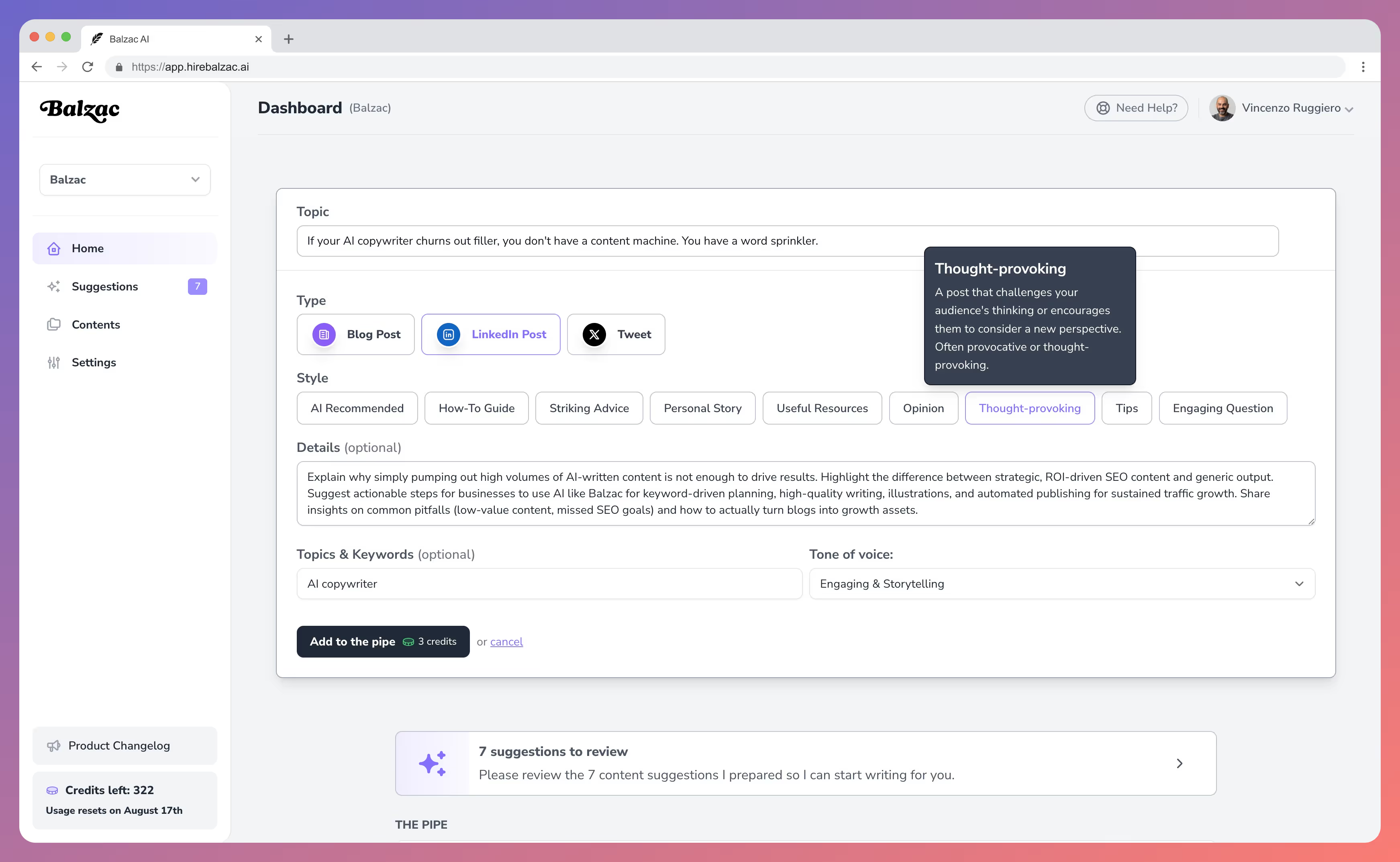Balzac turns your ideas into engaging content for your blog, LinkedIn, and X (Twitter).
Balzac learns your business, builds your content strategy, and writes SEO-optimized content, LinkedIn posts and X tweets (Twitter). He never gets tired, takes breaks, or misses a single deadline ;)

Long-form content that ranks on Google and surfaces in AI-generated answers.

Professional content that drives conversations and engagement on LinkedIn.
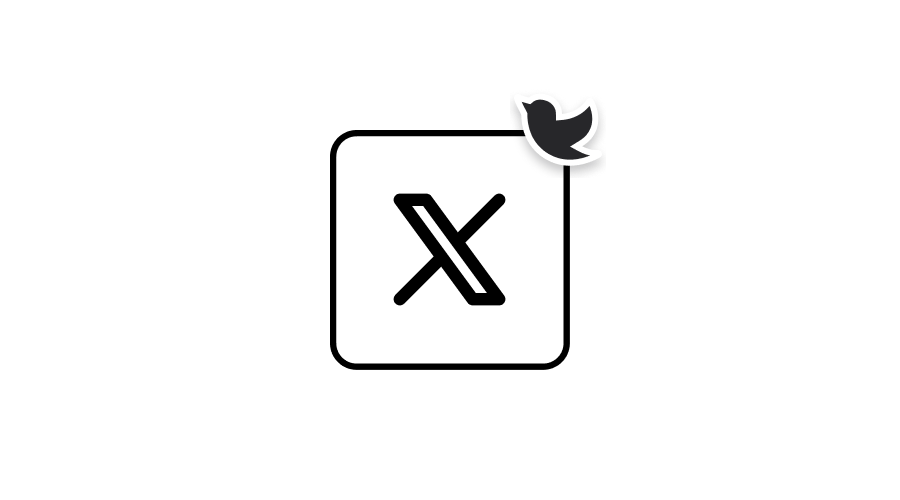
Concise content with viral hooks and bold takes, written in a natural, human voice.
Keep a consistent voice across platforms.
Fast content creation, optimized and ready to publish.
Automate the scheduling process by allowing users to book meetings instantly, without the back-and-forth of manual scheduling.
Automate the scheduling process by allowing users to book meetings instantly, without the back-and-forth of manual scheduling.
Automate the scheduling process by allowing users to book meetings instantly, without the back-and-forth of manual scheduling.
Automate the scheduling process by allowing users to book meetings instantly, without the back-and-forth of manual scheduling.




Automate the scheduling process by allowing users to book meetings instantly, without the back-and-forth of manual scheduling.
Automate the scheduling process by allowing users to book meetings instantly.
Get reminder of your meeting in your SMS and Email just 5 hours 3 hours and 30 minutes before of the meeting
You will get a meeting analytics dashboard whare you can see how long you have been meeting with how many people and others important insights.





WordPress site owners often struggle with the slow, repetitive tasks required for SEO publishing. Manually producing SEO content, researching keywords, updating on-page metadata, and tracking results eats into resources and delays growth. As competition intensifies, automating the SEO publishing process becomes essential for staying ahead. Automated workflows not only reduce time and cost but also provide consistent optimization, helping sites rank higher and attract more traffic.
| Component | Purpose | Example Tool | Main Benefit |
|---|---|---|---|
| AI Content Generation | Create SEO-optimized posts automatically | Balzac | High-quality, scalable drafting |
| Keyword Research & Discovery | Find target keywords and content ideas | SEMrush/Ahrefs | Data-driven content strategy |
| On-Page Optimization | Optimize meta tags, structure, internal links | Yoast SEO/Rank Math | SEO best practices by default |
| Scheduling & Calendar | Manage and publish posts automatically | Editorial Calendar/CoSchedule | Consistent publishing flow |
| Direct WordPress Integration | Publish content directly from creation tools | Balzac/ Wordable | No manual uploads needed |
| Performance Tracking | Monitor traffic and ranking automatically | Google Analytics/MonsterInsights | Instant feedback and insights |
| Collaboration & Approval | Automate team workflow and approvals | PublishPress/Trello | Faster teamwork, fewer bottlenecks |
| Continuous Optimization & Scaling | Update old posts and expand automation | Balzac/ SEO plugins | Keep SEO fresh as needs grow |
This article breaks down the eight most important components for automated SEO publishing. Each section explains how adding or improving these elements streamlines the workflow, saving time while steadily increasing website performance.
Automating content creation is the core of an effective SEO publishing workflow. Balzac uses artificial intelligence to generate SEO-optimized articles tailored for WordPress users. This automation offers a direct answer to the need for fresh, relevant content without constant manual input or reliance on external agencies.
Traditional content generation relies on teams of writers, editors, and SEO specialists—leading to higher costs and slower production. In contrast, AI-powered platforms like Balzac deliver speed, reliability, and consistent quality every time. This shift not only saves budget but also allows businesses and individuals to focus on higher-level strategy while automation manages routine content productivity.
Identifying the right topics and keywords is the starting point of any successful SEO workflow. Automated keyword research reduces guesswork, saving time while ensuring your content targets real user queries. Tools like SEMrush and Ahrefs connect with WordPress or content automation platforms to streamline this process.
Manual research can be slow and inconsistent. Using integrated solutions means relevant keywords, search volumes, and competitive data are always up to date. This helps you quickly find new content opportunities that match your audience’s needs. Automated tools can also surface emerging topics before competitors respond, keeping your content calendar relevant.
For sites using platforms like Balzac, automated keyword research is embedded in the content generation process. The platform analyzes your industry, competition, and search data to select keywords and recommend topic ideas that align with your SEO goals. This ensures that every piece of content is built on verified, keyword-driven insights—leading to better rankings and more targeted site traffic. For more insights on AI SEO strategy and automation, visit the Balzac Blog.
After producing SEO-friendly content and identifying strategic keywords, the next critical step is ensuring each post meets technical requirements for higher rankings. Automation here relies on advanced plugins that manage on-page optimization in real time.
Plugins like Yoast SEO and Rank Math enable WordPress users to automatically apply SEO best practices for every published post. Once installed and properly configured, these tools handle core on-page elements without manual edits for each page or article:
Automated plugins also deliver consistency across all content. Whether posts are published by Balzac or uploaded manually, the same rigorous standards apply, avoiding errors and missed opportunities. For teams aiming to scale content and compete for top positions, these tools offer a practical solution—and minimize the risk of technical SEO gaps.
Once your SEO content is ready, publishing it at the right time matters. Relying on manual posting can cause gaps in your content schedule or lead to missing key publishing windows. Automated content scheduling solves these issues by ensuring each article goes live according to a preset plan, helping maintain a steady flow and improving audience engagement.
Popular tools like CoSchedule and Editorial Calendar integrate directly with WordPress, allowing you to drag and drop posts onto a calendar interface. These platforms provide a clear overview of upcoming content, make it easy to fill gaps, and enable quick rescheduling if priorities change. You can also set recurring posting patterns or automate sharing across social channels to support your content strategy.
Platforms like Balzac also include built-in scheduling, letting you control when AI-generated articles appear on your site with minimal effort. Using scheduling tools as part of your automated workflow eliminates manual bottlenecks and keeps your site active, which not only supports SEO goals but also builds trust with your audience through a reliable posting rhythm.
Connecting automated content generation platforms directly to WordPress ensures your content transitions from draft to published with no extra steps or manual uploads. This integration not only saves time but also prevents errors that can occur when copying, editing, or reformatting outside of WordPress. By linking content pipelines to your CMS, every approved post gets published according to schedule—eliminating bottlenecks.
Seamless publishing integration allows teams to focus on content quality and SEO strategy while automation handles delivery and publication. It also ensures that metadata, images, and SEO tags stay intact, as plugins and automation scripts preserve these elements throughout the transfer. As a result, businesses can support a high-output SEO strategy without added complexity or risk of human error.
Once content goes live, understanding its performance is essential for refining your SEO strategy. Automated tracking tools capture crucial data with minimal manual oversight, helping you make better decisions and adapt more quickly.
Google Analytics and Google Search Console are the foundation for measuring user behavior and search visibility. When integrated with WordPress, these platforms automatically record metrics like page views, bounce rates, organic search queries, and indexing status. This automation removes the need for manual exports or log reviews and gives you current insights right from your dashboard.
Plugins such as MonsterInsights bring analytics data into the WordPress admin area and automate regular reports. You can set up weekly or monthly summaries, track goal completions, and get alerts for sudden changes in traffic or rankings—helping you catch issues early. These plugins turn raw data into actionable information, enabling you to respond to trends or problems quickly.
Platforms like Balzac further extend this automation by correlating content performance with publishing activity. By seeing which topics or formats drive the most engagement, you continuously refine your approach without manual comparisons or spreadsheets. Automated reporting ties every part of the SEO workflow together, ensuring growth is measurable and improvements happen fast.
As content production scales, manual coordination between writers, editors, and stakeholders often causes delays and miscommunication. Automated collaboration and approval workflows keep SEO publishing efficient by centralizing feedback, streamlining sign-offs, and tracking revisions in real time. This is essential for teams that rely on consistent, quality content delivery.
Automated platforms like Balzac integrate notification and approval settings, so teams see when a post is queued, reviewed, or published. This reduces manual follow-up and eliminates bottlenecks caused by lost feedback or unclear responsibilities. Together, these collaboration tools and features guarantee that SEO content not only gets published faster but also meets quality and compliance standards every time.
Maintaining strong SEO as content libraries grow is not just about publishing new articles. Automation ensures that older posts stay relevant and that your workflow can expand easily as demands increase. Automating updates, link management, and scaling processes keeps SEO performance high—and the workload manageable.
Regularly refreshing existing content is essential for maintaining search rankings and user engagement. Tools like Balzac and specialized WordPress plugins detect and flag outdated articles or SEO gaps. They can then suggest, or even apply, enhancements such as updated information, new visuals, or additional keywords. This ensures older content stays competitive without manual auditing of every post.
Broken links and outdated internal references harm site SEO and user experience. Plugins such as Broken Link Checker and Link Whisper monitor links site-wide and automate repairs or suggestions. These tools keep your content network healthy, distribute link authority, and save hours compared to manual checks.
As content production ramps up, scaling automation is key. Balzac enables users to increase publishing volume, manage updates, and distribute tasks across multiple WordPress sites—without added manual complexity. By automating repetitive SEO activities and expanding integrations, teams can focus on growth strategy rather than logistics. This approach keeps SEO performance steady through any scale of publishing.
The modern WordPress publishing environment demands more than scattered manual tasks. By bringing together AI-powered content creation, integrated keyword discovery, real-time on-page optimization, and automated scheduling, you build a repeatable process that saves hours every week. Features like direct publishing, collaborative approvals, and performance tracking transform SEO from a series of isolated steps into a connected, scalable system.
Leveraging platforms like Balzac adds another layer of simplicity—allowing you to delegate end-to-end content generation and publishing to a single autonomous system. This integrated approach directly addresses common challenges in SEO, from resource constraints to unpredictable content pipelines. To understand how users are benefiting from such systems, see Balzac AI testimonials.
By adopting these essential workflow components, WordPress users gain reliable processes, faster publishing cycles, and the ability to compete effectively in search results. Automated SEO publishing streamlines every stage, making ongoing optimization achievable for businesses and individuals committed to sustained growth.

Post to Anyone
AI didn’t steal your copywriting job. 𝗧𝗵𝗲 𝗯𝗹𝗮𝗻𝗸 𝗽𝗮𝗴𝗲 𝗱𝗶𝗱.
Every marketer knows the real villain is the slow, expensive grind of churning out content. Hours spent on keyword research. Endless outlines. High writer fees. And the worst part? Staring at a blinking cursor while your competitors rush past you. 😩
Most teams get stuck before the real work begins. Stats show manual SEO copywriting can eat up 70% of your content budget. Ouch.
𝗣𝘂𝗿𝗽𝗼𝘀𝗲-𝗯𝘂𝗶𝗹𝘁 𝗔𝗜 𝘁𝗼𝗼𝗹𝘀 𝗹𝗶𝗸𝗲 𝗕𝗮𝗹𝘇𝗮𝗰 𝗰𝗵𝗮𝗻𝗴𝗲 𝘁𝗵𝗮𝘁.
➡️ Research: Done automatically.
➡️ Content plans: Generated with a click.
➡️ Illustrations: Included, no extra hassle.
➡️ Publishing: Straight from your dashboard to your blog. 🚀
➡️ Quality and consistency? Not just maintained. Improved.
The busywork is handled. You get to focus on ideas and real strategy.
Let AI tackle the blank page. You handle the brand-building. 💡
Anyone else feel more fired up about creative work when the admin is gone? 🙋




Stop burning cash and energy on endless blog rewrites.
AI copywriting is not cheating. It's how smart operators finally escape the busywork trap.
If you want results, let go of old habits while your competitors cling to the past.
Time to evolve 🚀














When you subscribe to any paid plan, you'll receive credits depending on your plan's monthly allocation.
You can then use these credits for various tasks on Balzac:
→ Writing a blog post: 5 credits
→ Writing a LinkedIn post: 3 credits
→ Rewriting an article: 3 credits
→ Regenerating a picture: 1 credit
→ etc...
Learn more about our pricing.


No. Google has confirmed that it does not penalize AI-generated content as long as it’s helpful, original, and created for humans, not just search engines. You can read their official statement here.


Balzac can automatically publish content to your blog, LinkedIn, and other social media platforms. We're adding more integrations on a regular basis.


Yes, Balzac's articles are fully optimized for SEO. Each article includes SEO-optimized titles, meta descriptions, and naturally placed keywords throughout the content. We ensure proper heading structure (H2, H3) and maintain a minimum length of 2,500-3,500 words for best results.
The system also supports internal linking and can incorporate external references to boost SEO value.


Yes, Balzac will first make some content suggestions. You can approve them or make any changes before Balzac writes the full content. Once the content is ready, it will be saved as a draft by default. You can review it and make changes if needed.


Yes, when you integrate Balzac with your website, or your social media platforms using an integration, you can ask Balzac to auto-publish content. You can activate this feature in the workspace settings.


Yes, Balzac can write articles in more than 50 languages. Discover all available languages in this article.


We don't offer refunds.
That's why we give every user a free trial with 15 credits, so you can fully test the system before committing.
You can cancel your subscription at any time directly from your account.
If you're unsure, we recommend using the free credits first to see if Balzac is right for you.
Hire Balzac and tell your copywriter it’s not personal...
Contact

2025 © Balzac • All rights reserved • by Vincenzo.be SRL
